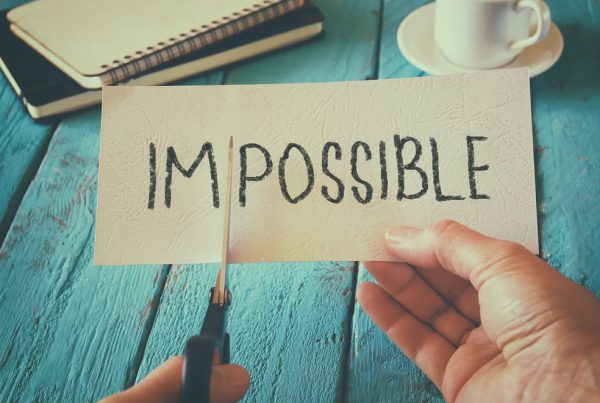Most of us find it difficult to change things. If you look at ordinary life and ordinary people, you will discover that they also find it very difficult to change things. Some people haven’t changed since they left school. At eighty years old they are still the same as when they left school.
Another curious phenomenon is that when you meet a person who knew you twenty years before, they still see you as you were twenty years ago. You have changed, but they do not perceive that change. For instance, a mother always looks upon a child as she did when she became fixated on the idea of that child — it could have been as a baby, as a small child or as a teenager.
Tradition: Still Waiting for the French Invasion?
Societies sometimes do things the same way for centuries. I never cease to be amused by traditions which have had no significance whatsoever for the past several hundred years. Apparently there is a guy at some point along the English coast, with very old-fashioned dress and old-fashioned binoculars, looking towards France, waiting for the French invasion.
Some centuries ago there was a rumour that the French navy was going to invade England, so they posted a sentry, and some guy is still looking with his binoculars for this invasion! This is what I mean about certain traditions which have absolutely no significance at all.
Why Is It Difficult To Change?
If you look at your own life, you will see many examples of traditions which have absolutely no relevance to modern day living. However, the idea is to look not into traditions, but into your thought-patterns.
Thoughts may come either from your own mind or from outside of you. Very often, thoughts do come from the outside and you don’t even know they are not your own. Observe the source of your thoughts: are they from other people? — are they your own? Also, observe what effects they have on you, for every thought has an effect.
Where Do Your Thoughts Come From?
Not all of your thoughts are from the present moment. Some are retained from early childhood, from school, parents, relatives, environment, work place, newspapers, books, public opinion, television, films, your religious and political upbringing, and so on. Many of these thoughts have crystallized into belief systems, such as religious or political biases.
There are two kinds of thoughts in your mind:
1. The rigid, fixed thoughts of the past, stored for years and years, which have built up into strong impulses.
2. Little thoughts of the moment which just happen to come across your mind now, as a result of talking with people, and so on.
You cannot perceive all of your thoughts at once; you only perceive one thought at a time, so you already are limited by that thought. Since you can perceive only one thought at a time, you cannot see any total situation at any given time. This is the problem: right from the time you are born until the time you die.
How To Change in Three Simple Steps
In order to change, you must do the following:
1. You must first observe how things really are.
Things can change only when they have been observed, when you have become aware of the situation. People often say, “I can’t help it, this is the way I am!” This means they don’t see things clearly in their minds. They do not see how they are. They are not looking at something.
2. You must introduce an extra force.
If an irresistible force meets an immovable object, what will happen? Nothing! When a third force is introduced, another situation is created immediately and a definite change takes place. This third force, or mediator, can be another person or a different type of energy.
The reason why you cannot change is because all of your forces are used up maintaining your established habit-patterns. This is why you have been sitting around for forty years with nothing happening: you are using up all of your forces simply to maintain the already established patterns. Therefore, in order to change you need an external agency, a third force, a catalyst.
3. There is one more important lesson: if you really want to change, you have to accept the third force. The next trick of the established patterns is that even if you decide to accept a third force, you still won’t accept its input. Old, established habit-patterns are so deeply rooted they reject the new energy or guidance and you are still stuck with them. You haven’t changed at all!
Being Willing to Accept Change
There may be a situation where two people have a basic problem and go to a third person for help. The third person, being impartial, will see the way out. Yet one or both of the people will not accept that decision and the situation remains as it was because the third force wasn’t allowed to act.
This is why people do not change: first, they don’t see the need to change; secondly, even if they do see that need, they don’t invoke the third force; finally, even if they do invoke the third force, they don’t accept it into their system. So they are back where they started and nothing has happened.
The Laws of Change
If you feel that you haven’t been changing much in your life, then look at these three points. These are the Laws of Change:
1. Have you observed yourself? Have you observed your situation?
2. Have you introduced a third force?
3. If you did introduce a third force, did you obey it?
If you understand these principles, every aspect of your life will radically change. The law is there, but you have to apply it. It is up to you to apply the principle of change.
كيف تتغير في ثلاث خطوات بسيطة
فبعض الناس لم يتغيروا منذ تركهم للمدرسة بل منهم من بلغ الثمانين من العمر ولم يتغير حتى الآن. الظاهرة الغريبة الأخرى هي أنّه عندما تلتقي بشخص يعرفك منذ عشرين عاماً، ستلاحظ أنّه لا يزال يراك كما كنت مذ عشرين عاماً.
وبالرغم من أنّك قد تغيّرت، إلّا أنّه لا يلاحظ ذلك التغيير. فعلى سبيل المثال تنظر الأم دائماً إلى صغيرها بالطريقة نفسها التي كانت تنظر فيها إليه عندما ترسّخت لديها فكرة ذلك الطفل– سواء كان طفلاً رضيعاً، أو ولداً صغيراً، أو مراهقاً.
التقاليد: هل ما زلت تنتظر الغزو الفرنسي؟ تعتمد المجتمعات أحياناً الطريقة نفسها للقيام بالأمور على مدى قرون عدّة. ولا أزال حتى اليوم أضحك عندما أرى تقاليداً خالية من أيّ معنى يتمّ تناقلها من جيل إلى جيل. فعلى ما يبدو هناك شخص لا يزال ينتظر على شواطئ الساحل الإنكليزي بثياب قديمة وهو يحمل في يديه منظاراً عتيقاً ويترقّب وصول الغزاة الفرنسيين. قبل عصور خلت سرت شائعة عن احتمال وصول الأسطول الفرنسي لاحتلال إنكلترا، فتمّ تكليف حارس بمراقبة الشاطئ، وعلى ما يبدو لا يزال أحدهم يترقّب وصول أولئك الغزاة من البحر حتى اليوم! لماذا من الصعب أن تتغيّر؟ إذا نظرت إلى حياتك اليوم ستجد العديد من الأمثلة عن تقاليد لا تمتّ إلى أسلوب الحياة العصرية بصلة. ولكن لا تنظر إلى هذه التقاليد بحدّ ذاتها، بل إلى نمط تفكيرك. راقب مصدر أفكارك: هل هي أفكار أناس آخرين؟ هل هي أفكارك أنت؟ وراقب أيضاً كيف تؤثّر عليك، فلكلّ فكرة تأثير ما.
من أين تأتي أفكارك؟
أفكارك ليست جميعها وليدة اللحظة الحاضرة، فبعضها مُخزن بداخلك منذ سنوات الطفولة الأولى أو أيام المدرسة، وبعضها الآخر مكتسب من أهلك، أو أقاربك، أو البيئة التي نشأت فيها، أو مكان عملك، أو الصحف، أو الكتب، أو الرأي العام، أو التلفزيون، أو الأفلام، أو تنشئتك الدينية والسياسية… إلخ.
وقد يتحوّل العديد من هذه الأفكار إلى أنظمة عقائدية لديك، مثل تحيّزك السياسي. وهناك نوعان من الأفكار في ذهنك:
1. الأفكار الثابتة من الماضي، المحفوظة في الذهن منذ سنوات طويلة، والتي تطوّرت مع الوقت حتى أصبحت اندفاعات قوية
. 2. الأفكار الصغيرة وليدة اللحظة، والتي تخطر في بالك نتيجة تحدّثك إلى الناس وما إلى ذلك. ولا يمكنك أن تدرك أفكارك كلّها في آنٍ واحد، بل تدرك كلّ فكرة على حدة، لذا تقيّدك تلك الفكرة مسبقاً. وبما أنّك لا تستطيع أن تدرك إلّا فكرة واحدة في كلّ مرّة، لا يمكنك أن ترى أيّ موقف بكلّ أبعاده في الوقت نفسه. كيف تتغيّر في ثلاث خطوات بسيطة من أجل أن تتغيّر،
عليك أن تقوم بما يلي:
1. عليك أن تراقب الأمور أولاً لتراها على حقيقتها. يمكن للأمور أن تتغيّر فقط بعد أن تراقبها، أي عندما تصبح مدركاً للموقف.
2. . عليك أن تُدخل قوّة إضافية إلى المعادلة. إذا تلاقت قوّة لا يمكن مقاومتها مع شيء لا يمكن تحريكه، ماذا سيحدث؟ لا شيء! ولكن عندما تُدخل قوة ثالثة إلى المعادلة، يتكوّن موقف آخر على الفور ويحدث التغيير لا محالة. ويمكن لهذه القوة الثالثة الوسيطة، أن تكون شخصاً آخراً أو نوعاً مختلفاً من الطاقة. ويكمن سبب عدم قدرتك على التغيير في أنّ جميع قواك يتمّ توظيفها للحفاظ على أنماطك السلوكية الثابتة. لذا، من أجل التغيير، أنت بحاحة إلى وساطة خارجية، إلى قوّة ثالثة، إلى محفّز. 3. هناك درس مهمّ آخر: إذا كنت ترغب حقاً في التغيير، عليك أن تقبل بالقوة الثالثة. إن أنماطك الثابتة تحول دون قبولك بما ستقدّمه لك القوّة الثالثة، حتى لو وافقت على القبول بها، ذلك أنّ الأنماط السلوكية الثابتة والقديمة متجذّرة بعمق في داخلك بحيث ترفض أيّ طاقة أو توجيه جديد. فلا تتغيّر على الإطلاق! الاستعداد للقبول بالتغيير قد يحصل موقف يواجه فيه شخصان مشكلة أساسية ويلجآن إلى شخص ثالث للمساعدة. فيدلّهما هذا الأخير، كونه غير متحيّز، إلى المخرج. ولكن لا يقبل أحد الطرفين أو كلاهما بذلك الحلّ فيبقى الوضع كما هو عليه لأنّه لم يُسمح للقوة الثالثة بأن تتصرّف. هذا هو سبب عدم تغيّر الناس: أولاً، هم لا يرون الحاجة إلى التغيير؛ ثانياً، حتى لو رأوا تلك الحاجة، هم لا يُدخلون قوّة ثالثة إلى المعادلة. وأخيراً، حتى لو أدخلوا قوّة ثالثة إلى المعادلة، هم لا يرحّبون بها في داخلهم.
قوانين التغيير: إذا كنت تشعر بأنّك لم تتغيّر كثيراً خلال حياتك، أنصحك بأن تنظر جيداً إلى النقاط الثلاث التالية. فهذه هي قوانين التغيير: 1. هل راقبت نفسك؟ هل راقبت وضعك؟ 2. هل أدخلت قوّة ثالثة إلى المعادلة؟ 3. إذا أدخلت قوّة ثالثة إلى المعادلة، هل أصغيت إليها؟ إذا فهمت هذه المبادئ، سيحدث تغيير جذري في كلّ جانب من جوانب حياتك. فالقانون موجود، لكن عليك تطبيقه. ويعود تطبيق مبدأ التغيير لك
وحدك
بقلم:إمري فاليون
Photo by Aziz Acharki is licensed under CC0









